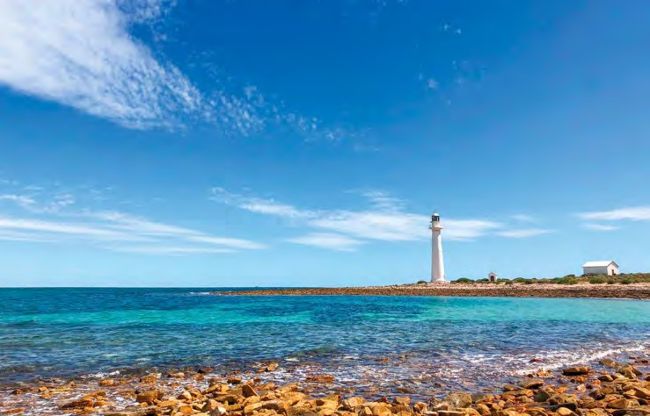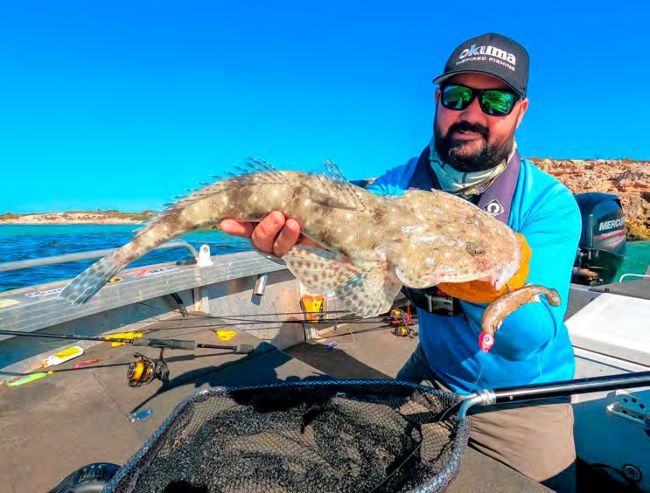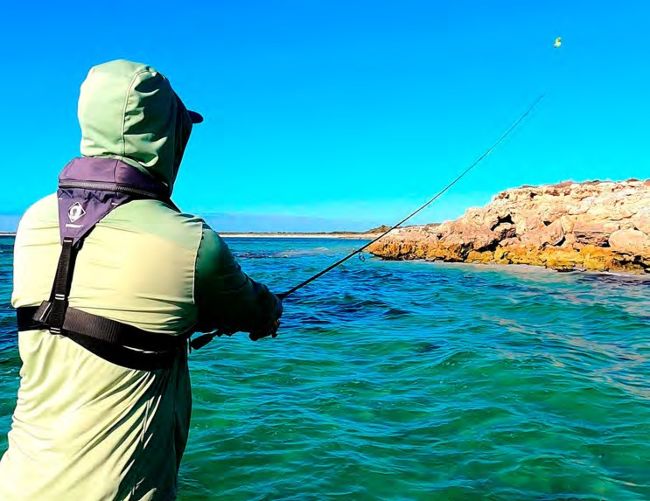A WEEK ON THE WEST COAST
Lubin Pfeiffer relives his most recent trip to some of SA’s most productive inshore waters. It’s a flathead extravaganza!
The Eyre Peninsula, on our state’s west coast, is without a doubt one of my favourite spots to spend a week fishing. It is such a diverse location with plenty of fishing variety. It also has plenty of options to fish in different areas depending on the weather. Once you’re there, a short drive can put you in the best place for the wind predicted for the day. This means you are always going to have something cool to fish for, no matter what the forecast has thrown at you that morning.
From Adelaide, Port Lincoln is a comfortable seven-hour drive. I always plan to add a couple of stopover points on the way, not only to break up the drive, but there are some good fishing opportunities right along the west side of the Spencer Gulf. After just coming back from my annual trip out west, I’ll run you through what happened where and what was on the bite!
DAY ONE - DRIVING DAY
The best trips start well before you hit the highway, and I had been spending quite a lot of time in the shed getting all the tackle and gear organised. I always make sure my reels have fresh braid, lures are sorted into boxes and the boat has everything in place. This way, when I’m on the road, I don’t need to waste too much time. It’s hard to know just exactly how a trip is going to go down, so you always end up sorting some stuff while away, but at least the majority was done.
One of the best purchases my wife and I have ever made is an old Transit van, which we fitted out as a camper for long-range trips. This is truly our home away from home. Having the van (aka “Kevin”) means that we could take advantage of the many free camps right around the Eyre Peninsula. Once the bed has been made, and the fridge and gear have been packed, I can drive to wherever I need to and stay as long or as little as I like. I can also head off to find good weather at the drop of a hat. It is this flexibility that allows me to make the best of a trip without having to constantly work out where the next accommodation is going to be or having to roll out the swag each night. Don’t get me wrong, I enjoy sleeping in a swag, just not when the weather turns nasty! So, with everything sorted, Kevin and I headed out of the driveway to the west.

Point Lowly, north-east of Whyalla, is always a good starting point
The first stop for an overnighter is usually Point Lowly, near Whyalla. In years past my trip to the West Coast has been a little later into winter, but this time it was during autumn. Point Lowly is a favourite place of mine to chase a feed of squid. After a long stint chasing fish in the Murray River, I was keen for a fresh feed from the salt. Squid are also a stack of fun to catch. I like to use a specifically designed EGI rod, which is around eight feet in length with quite a parabolic action. This just makes the whole process of slinging jigs over the weed beds just that little bit more fun!
Unfortunately, the squid were few and far between at Lowly, and after working hard to catch one for the morning, I loaded the boat back on the trailer and headed further down the coast. The next stop was an awesome cafe in Cowell for a pie and coffee before heading into Port Neill for a look at the water to see what the wind was doing. As it turned out, the wind was blowing a bit too hard to justify launching to boat to look for some squid, so I made the call to finish the road trip at Farm Beach near Coffin Bay to be ready for the morning. A mate and I had made plans for a catch-up and land-based flathead mission, with the wind and swell looking ideal for the next morning.
DAY THREE - LAND-BASED FLATHEAD
Normally I wouldn’t be too fussed about getting onto the water right at dawn when I’m chasing flathead, but my mate Russ was very keen and assured me it would be worth it. After the first good-sized fish hit the sand not long after, I was very happy we did. The sky was a beautiful pink and blue as the sun rose over the horizon in the east, and we were having some of the best land-based fishing for flathead I had experienced; not only the size of the fish, but the fact that every good-looking spot had one ready to pounce on your plastic. Russ was using a Zman 4’ Diezel Minnowz in new penny colour rigged on a 1/6oz hot pink TT snakelockz jighead, and I was using a Zman 4’ Mulletron in sexy mullet rigged on a 1/4 snakelockz jighead in chartreuse. Both are very similar baits, but for some reason Russ was getting more than his share of bites. He then explained to me that he was adding a rattle to the plastic with the Rattle Snaker tool I gave him last year. The tool allows you push a glass rattle inside the body of the plastic, which adds a noticeable sound to the lure.

Big flathead provided non-stop action
Being early in the morning and with low swell and very little sound of the waves crashing, the flathead were obviously homing in on the rattle sound a lot more than the bait without a rattle. It’s very cool to watch when someone is having a dream day and Russ, with a big grin on his face, put on a clinic on catching flathead, pretty much one after the other. There were some nice ones ranging from 40-55cm before the big one came along.
After a heated fight in amongst some gnarly West Coast kiss (Russ’s name for the incredibly sharp rock that lines quite a lot of the West Coast), a beautiful bluespot of around 60cm was pulled up onto the sand for a quick photo. It was interesting to see that the fish bit so well during the first light period and then we had a little bit of a quiet patch until the first rays of sun hit the water and the fish fired back up again. It was such a great start to the trip and really set the scene for the rest of the upcoming week.
SETTING A PLAN FOR THE WEEK
Usually on my West Coast trips I try to fit as many different things in as possible, but this time, after having such great fun on the flathead, I decided to just pig out on them for the following days. The predicted wind and swell were perfect, and rather than try to hurry around and fit everything in, it was nice to settle into the Coffin Bay area and target one specific fish. What I like about the flathead fishing is that you can do it in a bunch of different locations, from either the shore or out in the boat, so every day seems quite different to the one before.
The following morning I revisited the stretch of coastline that Russ and I had fished the day before. Rather than spend too long in the areas we fished the previous day, I worked through that water pretty quickly before making it to fresh ground. This turned into another amazing morning of fishing. The size and quantity made for some great filming for the show I was making for my YouTube channel “The Full Scale”, and this morning’s session can be found on the channel now if you’re keen to see how it went down!
The morning was topped off with what is probably my personal best shore-based flathead with a mid-60s fish that smacked a 4’ Mulletron in a beautiful pocket along the beach. After getting the hang of flathead fishing over the last several years, a ‘pocket’ is so obvious when you get to one and you know what you are looking for. Its where the water gets a little deeper close to the edge of the sand, has good cover like rock and a weed bed or two, and has a very distinct clear sandy patch. It’s the perfect spot for a flathead to sit waiting to ambush any prey that may come into range. Quite often there may only be one or two of these prime pockets along a beach, but I always get excited throwing the lure into them because you are almost guaranteed for your bait to get clonked!
Over the rest of the trip I alternated between expeditions out in the boat, fishing the shallow rocky coastline under electric motor power picking all the likely spots and fishing them with a plastic, and walking the sand fishing the same technique. Like every trip, each day was planned around the wind and I can’t speak highly enough of the app called Windy, as this allows you to see exactly what the wind direction is doing. It is usually pretty accurate too. There are two different forecast models that I use on the app; firstly the ECMWF model, which is the default one, and then the GFS model. If I have glamour predictions, I just look at the first one, but if the wind is questionable, it often pays to look at both to make sure you don’t run into trouble.

The author with a monster blue spot flattie
I’ve been really enjoying doing long-range missions to explore some of the hard to get to flathead spots in the boat, but being down the southern end of the country, you need to make sure the weather forecast is right before heading out. I have found that looking at multiple forecasts is the best way to make sure you don’t head out wide on a day you really shouldn’t have. From what I have found, the best flathead fishing comes when the water is nice and clear, and usually these areas can be found when the wind is blowing off the shore rather than into it. So, if the wind was blowing offshore along a stretch I could access on foot, that would be the order of the day. Otherwise, I’d launch the boat and travel to an area that had offshore wind. Each day I’d average between 10-20 fish, which was just such good fun!
TRIP HIGHLIGHTS AND INTERESTING CAPTURES
The biggest highlight of the trip was the consistently amazing flathead fishing regardless of the location. It has really restored some of my faith in SA fishing. In my opinion, the bluespot flathead fishing on SA’s Eyre Peninsula is the best it could be – great numbers of fish, good average size and a vast range of locations, rather than just one hot spot everyone is there hammering. More often than not, you can spend the whole day flicking lures around and not run into another angler.

Fresh flathead fillets are hard to beat
On one of my days on the boat a large shape appeared cruising down the sand, which turned out to be a mid-sized bronze whaler chasing salmon. It came all the way down the beach before coming up to the boat for a look and then cruising back out again. On another day fishing land-based, I had something happen that had never happened to me before – a quite large octopus grabbing the Mulletron. These clever creatures are alien-like in appearance, and I’ll admit I was very unsure how I was going to detach the octopus from the hook. Luckily, it fell off at my feet before gliding back to the cover of the weed bed it came from. If I could offer one piece of advice to anyone who is planning on starting chasing blue spots is to be respectful of the fishery. These very aggressive fish love to smack lures, but it is important that we release more than we take. That way the fishery should thrive and we can enjoy it for many years to come. Once again, it had been a get trip over to the west, I’m already looking forward to getting back there!

Prospecting the inshore wash zone